Can you think of a more intense situation? Preparing a potluck dish for a bunch of food bloggers, writers, and photographers? I was questioning the wisdom of even having suggested it. But eventually, I worked out in my head that this was the crowd on which to try out something that my regular crew may not really go for, something I may not be willing to make otherwise. And then, after a friend suggested I make pate, I remembered a recipe for Country Pate that I had been saving for the right opportunity.
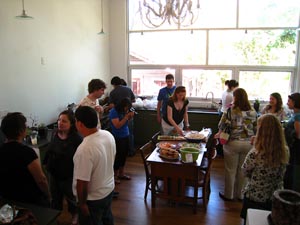
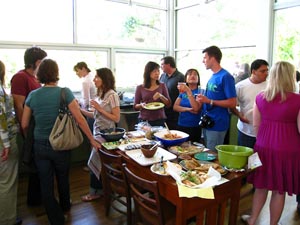
This past weekend’s event, a well-attended food blogger pot luck, turned out to be the perfect venue to test out my first ever pate experiment. Everyone generally seemed to like it, and I’d like to assure you now, there was some stiff competition (not that it was really a competition – there was just soooo much food to try, you wound up having to pick and choose a little bit). I don’t want to hurt anyone’s feelings with omissions, so I’ll keep my favorites to myself, but the variety of foods people brought was incredible. Penny De Los Santos kindly hosted the event at her gorgeous south Austin home, and the relatively mild weather was just about perfect.
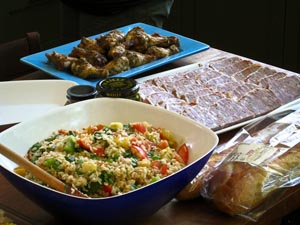
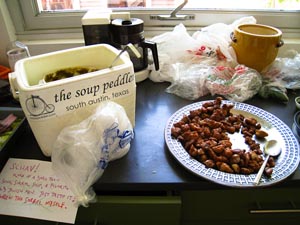
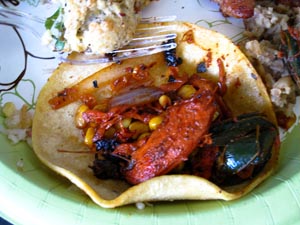
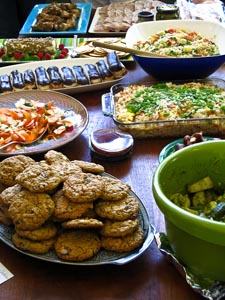
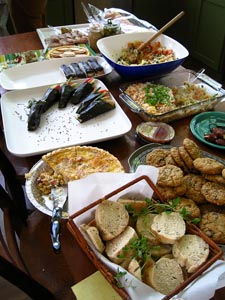
As for the pate … It’s no secret that I find lots of recipes to love at the Orangette blog. Well, Molly also writes a column for Bon Appetit called Cooking Life, and a few months ago, she featured a beautiful country pate. This should more properly be called Pate de Campagne, but my French pronunciation is wretched. Even if I do stumble my way into pronouncing something correctly, it comes off sounding like I’m trying too hard. Or I sound like Pepe le Pew. Either way, it’s not pretty.
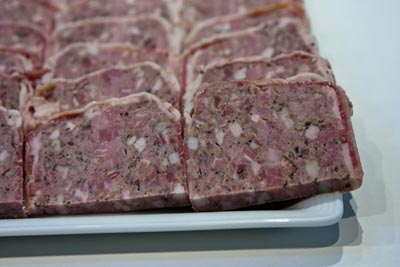
This pate, regardless of what you call it, was fantastic. It even got the thumbs up from a real French lady! I am giving over the credit to the recipe – it’s a good one. It was very easy to make and was delicious served with dijon mustard and cornichons (little French pickles) and some crusty French bread. Turns out, it’s actually also reasonably tasty when plunked between two halves of a buttermilk biscuit dressed with mustard. Plus, if you have any misgivings about cooking with liver, this pate doesn’t have any. It does, however, make ample use of a variety of lovely pork products, so I’d highly recommend making this only if you have a crowd to share it with.
One last note, the seasonings in the recipe seemed sort of heavy-handed to me; however, with well over three pounds of meat and fat to flavor, the seasonings were just about perfect. The resulting pate was rich and dense, the subtle flavorings complementing the meat rather than overpowering it. I cut my pate into probably about twenty slices and then cut each slice in half to make the portions a bit more manageable.
In a small sauce pan, boil the cognac till reduced to ½ cup. Set it aside to cool.
With the oven rack at its lowest position, preheat the oven to 350 degrees.
Melt the butter in a heavy 10" skillet over medium heat. Saute the onions in the butter till they’re soft and translucent, but not yet browned, roughly 8 minutes. Set aside to cool.
Combine the ground pork and chopped bacon in a very large bowl. Add the sauteed onion, garlic, and all the herbs and spices to the pork mixture and stir to thoroughly distribute. Finally, add the eggs, cream, and cooled cognac and mix until completely blended.
This is the part I thought was trickiest (amusingly enough). Line a 9" x 5" x 3" metal loaf pan with the bacon strips. Begin by laying 8 strips, just overlapping, across the width of the pan. Next, lay three strips on either end. I chose the midpoint of the bacon strip, placed it against the top edge of the pan, and then pressed it in from there. There’ll be a lot of bacon hanging off either end of the loaf pan, but it will help with closure later.
Divide the ground meat mixture in half. I wound up with a 3 ½ cups in each half. Molly wound up with 3 ¼. Who knows why these things happen. It doesn’t especially matter if it’s perfectly divided.
Carefully press the first half of the pork mixture into the bacon-lined pan such that air pockets are minimized. It may seem a little gross, but your hands really are the best tools for this job. Arrange the ham strips over this in a single layer. Then mash in the other half of the pork mixture. It will completely fill the loaf pan and then some.
Next, fold the 8 strips of bacon over the ground pork mixture. Mine didn’t completely cover the top, but that’s ok because those long danglers on either side of the pan did cover it and did a nice job of sort of cinching down the stubby side pieces. Cover the completed raw pate tightly with aluminum foil.
Place the loaf pan into a 13" x 9" x 2" metal baking pan and place the whole thing into the oven. Next add boiling water to the larger pan to come halfway up the side of the loaf pan. I highly recommend doing this once the pan is in the oven. It’s very difficult to move a pan filled with several pounds of pate plus several cups of boiling water from the counter to the oven without 1. burning yourself and / or 2. making a mess. Bake the pate until it reaches an internal temperature of 155 degrees (F). I did this by plunking a probe thermometer through the top of the foil into the fattest part of the pate. Start checking the temperature at about the 2 hour mark. Mine wound up taking about 2.5 hours.
Remove the loaf pan from the oven and place it on some sort of overflow catching device. Molly suggests a rimmed baking sheet. My loaf pan fit neatly into a quarter sheet pan, so that’s what I used. Place a weight on top of the pate. Some people use foil-wrapped bricks or specially made weights. Since the pate so completely filled the loaf pan, I was able to get by with a 12" cast iron skillet to which I added a few cans of vegetables for good measure. You will immediately see why you needed the baking sheet as some liquid will already be flowing out of the pan. Move the whole apparatus to the refrigerator to cool at least overnight and up to four days.
When it’s time to un-mold the pate, place the loaf pan into a larger bowl or pan of hot water to loosen the congealed fat. After a couple minutes, carefully overturn your pate on a cutting board. I spent a few minutes cleaning some of the less savory looking fat globs from the side, though I doubt it’s necessary. While the pate is still cold, carefully slice it into roughly ½" thick slices. The cross-section with the ham strips in the middle is very pretty.